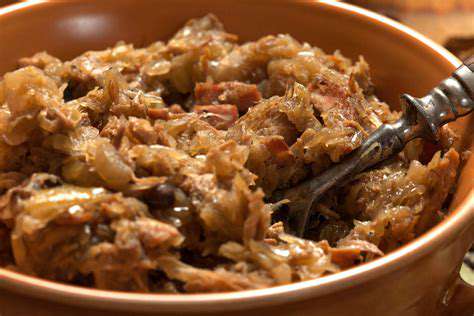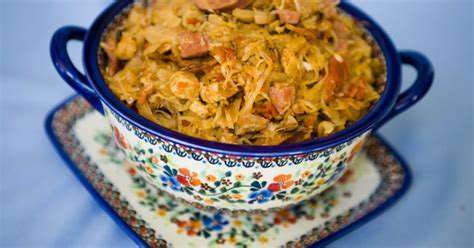Exploring Polish Cuisine: Bigos and More
Bigos: A National Treasure, Briefly Explained

A Polish Culinary Masterpiece
Bigos, a hearty and flavorful Polish stew, is renowned for its complex blend of meats and vegetables. It's a dish that's deeply ingrained in Polish culture, often served at gatherings and celebrations. The rich history and traditional preparation methods contribute to its unique character, making it a true culinary treasure.
This dish truly embodies the spirit of Polish hospitality and communal eating, often enjoyed in large gatherings and family dinners. The aroma of simmering meats and vegetables, often including sauerkraut, is a comforting and evocative experience for those who enjoy it.
The Essence of Bigos
The key to a great bigos lies in the careful selection of ingredients and the extended cooking time. The slow simmering process allows the flavors to meld together, creating a symphony of tastes that tantalizes the palate. Different regions of Poland have their own variations and preferences, but the core ingredients usually include pork, beef, and often wild game, creating a deep, savory flavor.
Often, the addition of smoked meats adds an extra layer of richness and smoky aroma to the dish. This enhances the overall experience and creates a truly unforgettable flavor profile. The ingredients work harmoniously together, creating a truly unforgettable dish.
Beyond the Basic Recipe
While the basic recipe often focuses on pork and beef, many variations exist, showcasing the adaptability and creativity of Polish cuisine. Some regional variations include the inclusion of mushrooms, apples, or even prunes, which add unique textures and flavors to the stew.
The ability to customize the dish to one's tastes is one of the great appeals of bigos. This adaptability makes it a favorite for both casual and formal gatherings. It's a testament to the versatility of Polish culinary traditions.
A Celebration of Tradition
Bigos isn't merely a meal; it's a celebration of Polish heritage and culinary tradition. The preparation of bigos is often a communal affair, bringing families and friends together in the kitchen. This shared experience reinforces the strong bonds within Polish communities.
The rich history and cultural significance of bigos are intertwined with its delicious taste and comforting aroma. It embodies the spirit of Polish hospitality and culinary artistry, making it a beloved and cherished dish throughout Poland and beyond.
Beyond Bigos: A Symphony of Flavors

Beyond the Expected: Polish Cuisine's Diverse Palettes
Polish cuisine, often stereotyped as heavy and hearty, boasts a surprising array of flavors and textures, extending far beyond the iconic Bigos. Exploring Polish culinary traditions reveals a rich tapestry of regional specialties, each with its own unique character. From the delicate flavors of pierogi stuffed with various fillings to the savory aroma of żurek, a sour rye bread soup, Polish food offers a true journey for the palate.
This diverse culinary landscape reflects centuries of cultural exchange and influences, showcasing a rich history that goes beyond the borders of Poland. Understanding the nuances of these regional specialties allows us to appreciate the complexity and depth of Polish cuisine, moving beyond the preconceived notions of simple dishes.
The Art of Pierogi: A Culinary Masterpiece
Pierogi, the beloved Polish dumplings, represent a culinary masterpiece in themselves. Their versatility is astounding, with countless variations in fillings, from savory meats and cheeses to sweet fruits and vegetables. This seemingly simple dish is a testament to the creativity and innovation of Polish cooks.
Beyond the Hearty: Lighter Polish Dishes
While hearty dishes like Bigos are undoubtedly a staple, Polish cuisine also includes a variety of lighter options. Salads, often featuring fresh vegetables and local herbs, provide a refreshing counterpoint to heavier meals. These lighter options highlight the importance of fresh ingredients and seasonal produce in Polish culinary traditions. The use of fresh ingredients and seasonal produce contributes to the overall enjoyment of the meal.
Light and refreshing dishes offer a welcome contrast to the more substantial fare, ensuring a well-rounded dining experience.
The Impact of History on Polish Cuisine
Polish cuisine is deeply rooted in the country's history, reflecting the various cultures and influences it has absorbed over the centuries. From the influence of neighboring countries like Germany, Ukraine, and Russia, to the enduring traditions passed down through generations, Polish food is a vibrant tapestry woven from threads of diverse experiences. This rich history is palpable in the flavors and techniques used in Polish cooking.
The interplay of these influences has resulted in a uniquely Polish culinary identity. This diverse heritage is beautifully reflected in the rich array of ingredients and cooking methods found in Polish dishes.
The Importance of Local Ingredients: A Celebration of Seasonal Flavors
A crucial element of Polish cuisine is the emphasis on using fresh, local ingredients. The awareness of seasonal availability shapes the dishes, ensuring optimal flavor and freshness. This focus on seasonal produce is not just a culinary practice but a celebration of the natural world and its bounty. This approach to cooking highlights the importance of sustainability and connection with the local environment.
The use of fresh, local ingredients elevates the dishes to new heights, showcasing the best that Polish agriculture has to offer.
Pairing Polish Food with Polish Drinks: A Perfect Match
Understanding the Polish Palate
Polish cuisine, with its rich history and diverse regional influences, offers a fascinating tapestry of flavors. From hearty stews to delicate pastries, each dish tells a story. This understanding of the culinary landscape is crucial when pairing food with beverages, as different tastes and textures require different complements.
The Polish palate often leans towards savory and robust flavors. This preference, rooted in traditional recipes and local ingredients, often translates to a desire for drinks that can stand up to the richness and complexity of the food.
Vodka: The Iconic Polish Spirit
Vodka, arguably the most iconic Polish spirit, is a versatile choice for many Polish dishes. Its neutral character allows it to complement a wide array of flavors, from the savory richness of pierogi to the tangy notes of żurek. Vodka's smooth, clean taste also makes it a great option for enjoying on its own, particularly when enjoyed neat or with a slice of lemon.
While vodka is a popular choice, it's important to consider the specific recipe and flavor profile of the dish when pairing it with vodka. Some dishes might benefit from a more robust vodka, while others might call for a milder variety.
Wine: A Sophisticated Complement
Wine, particularly red wines with moderate tannins, can provide a sophisticated complement to many Polish dishes. The earthy flavors of red wines, such as Pinot Noir or Merlot, pair well with hearty stews like bigos or żurek. The acidity of the wine can cut through the richness of the food, creating a harmonious balance.
Certain Polish dishes, like those featuring mushrooms or game, can also benefit from a full-bodied red wine, which can stand up to the complex flavors. The choice of wine should always be based on the specific ingredients and overall flavors of the dish.
Beer: A Refreshing and Versatile Option
Polish beer, with its diverse styles and flavors, offers a refreshing and versatile pairing option. The crispness of light lager beers can complement lighter dishes, while the more robust flavors of darker ales or porters pair well with richer, heartier meals.
The choice of beer can also be influenced by the specific region from which the dish originates. Regional variations in beer styles often complement the unique flavors and characteristics of the local cuisine.
Liqueurs and Fruit Brandies: Sweet and Savory Combinations
Liqueurs and fruit brandies, such as the popular Polish cherry liqueur, offer a sweet and savory pairing option for desserts, sweet and sour dishes, and some savory dishes. These drinks can enhance the flavor of desserts and complement the sweet and sour flavors of certain dishes.
Traditional Polish Drinks: Beyond the Mainstays
Beyond vodka, wine, and beer, exploring traditional Polish drinks like honey mead or herbal infusions can offer unique and exciting flavor profiles. Honey mead, with its sweet and slightly smoky notes, can complement desserts or savory dishes with a touch of sweetness. Herbal infusions, often incorporating local herbs and spices, offer a refreshing and flavorful alternative, particularly when served chilled.
These traditional drinks often reflect the rich history and cultural heritage of Poland, adding a unique dimension to the dining experience.
- Simple Salmon Patties: Quick and Healthy
- Vegetarian Dinner Party Ideas: Impress Your Guests
- Whole30 Meal Planning: Simple and Compliant Recipes
- Homemade Brownies: Fudgy and Irresistible
- Diabetic Friendly Desserts: Sweet Treats without Sugar
- Understanding Mindful Eating: Enjoy Your Food
- Kid Friendly Snack Ideas: Healthy and Fun Recipes
- Storing Fresh Ginger Root: Preserve Potency
- Boosting Your Metabolism with Food: Recipes for Energy
- Low FODMAP Diet Recipes: Gut Friendly Meal Ideas
- Vegetarian Breakfast Burritos: Hearty and Flavorful
- Kitchen Faucet Finishes: Style and Durability